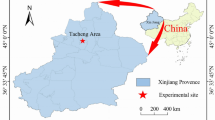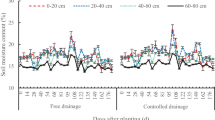Abstract
Soil salinization is a global issue that results in soil degradation and affects the sustainable development of irrigated agriculture. A 2-year study was conducted in 2018 and 2019 to identify the effect of subsurface drainage spacing on soil moisture, salt, cotton growth, and yield under the Tarim Basin oasis in China. The tests involved three subsurface drainage treatments, with a pipe spacing of 10 m (W10), 20 m (W20), and 30 m (W30), respectively, and a drainage-absent treatment (CK). Compared with CK, subsurface drainage reduced soil salinity, resulted in better uniform water distribution and reduced inorganic salt concentration in shallow soil solution. In addition to improving soil moisture and salinity conditions, subsurface drainage increased seedling emergence rate (28%), root vigor (23%), and chlorophyll content (44%) of cotton, which in turn led to increases in cotton plant height (18%), leaf area (33%), dry matter weight (32%), and reproductive organ weight (39%), thereby resulting in high cotton yield (45%). A path analysis revealed that under subsurface drainage, the seedling emergence rate of cotton had the greatest impact on cotton yield, and subsurface drainage contributed the most to the increase in cotton yield. It increased the seedling emergence rate by reducing soil salinity. Moreover, cotton yield and next-year soil arability increased with decreasing drainage pipe spacing, suggesting that it is advantageous to adopt a drainage pipe layout with small pipe spacing when economic costs are not a concern.










Similar content being viewed by others
References
Akhter J, Murray R, Mahmood K, Malik K, Ahmed S (2004) Improvement of degraded physical properties of a saline-sodic soil by reclamation with kallar grass (leptochloa fusca). Plant Soil 258(1):207–216
Aragüés R, Medina ET, Zribi W, I C, álvaro-Fuentes J, Faci J, (2015) Soil salinization as a threat to the sustainability of deficit irrigation under present and expected climate change scenarios. Irrig Sci 33(1):67–79
Bahceci I, Nacar AS (2009) Subsurface drainage and salt leaching in irrigated land in south-east turkey. Irrig Drain 58(3):346–356
Chaves MM, Flexas J, Pinheiro C (2009) Photosynthesis under drought and salt stress: regulation mechanisms from whole plant to cell. Annals Bot 103(4):551–560
Christen E, Skehan D (2001) Design and management of subsurface horizontal drainage to reduce salt loads. J Irrig Drain Eng 127(3):148–155
Du J, Chen Z (2010) Path analysis using SPSS linear regression. Bull Biol 02:8–10 (in Chinese)
Enciso J, Nelson S, Perea H, Uddameri V, Kannan N, Gregory A (2014) Impact of residue management and subsurface drainage on non-point source pollution in the Arroyo Colorado. Sustain Water Qual Ecol 3:25–32
Evan WC, James EA, John WH (2001) Subsurface drainage design and management in irrigated areas of Australia. Irrig Sci 21(1):35–43
FAO (2020) Management of salt affected soils: ‘soil management’ under ‘FAO soils portal’. In: ‘Food and Agriculture Organization’ of the ‘United Nations’. Rome, Available at: http://www.fao.org/soils-portal/soil-management/management-of-some-problem-soils/salt-affected-soils/more-information-on-salt-affected-soils/en/. (Accessed 9 April 2020)
Fayrap A, Ko C (2012) Comparison of drainage water quality and soil salinity in irrigated areas with surface and subsurface drainage systems. Agric Res 1(3):280–284
Feng G, Zhang Z, Zhang Z (2019) Evaluating the sustainable use of saline water irrigation on soil water-salt content and grain yield under subsurface drainage condition. Sustainability 11(22):6431
Foad M, Ismail AM (2007) Responses of photosynthesis, chlorophyll fluorescence and ros-scavenging systems to salt stress during seedling and reproductive stages in rice. Ann Bot 6:1161–1173
Ganjegunte G, Clark J, Parajulee M, Enciso J, Kumar S (2018) Salinity management in pima cotton fields using sulfur burner. Age 1(1):1–10
Gong J, Bao J, Lv N, Hou Z (2009) Effects of different soil salinity levels on the distribution of cotton root in drip irrigation under film. Cotton Sci 02:138–143 (in Chinese)
Guan Z, Jia Z, Zhao Z, You Q (2019) Dynamics and distribution of soil salinity under long-term mulched drip irrigation in an arid area of northwestern china. Water 11(6):1225
He Q, Li S, Hu D, Wang Y, Cong X (2020) Performance assessment of the AquaCrop model for film-mulched maize with full drip irrigation in Northwest China. Irrig Sci 39(2):1–16
Hu X, Chen H, Wang J, Meng X, Chen F (2009) Effects of soil water content on cotton root growth and distribution under mulched drip irrigation. Sci Agric Sin 42(05):1682–1689 (in Chinese)
Kladivko EJ, Frankenberger JR, JaynesDB, Meek DW, Jenkinson BJ, Fausey NR (2004) Nitrate leaching to subsurface drains as affected by drain spacing and changes in crop production system. J Environ Qual 33(5):1803
Li Y, Zhang Y, Sun M, Gao B (2008) Effects of salt stress on plants and the mechanism of salt tolerance. Chinese Agric Sci Bull 24(001):258–265 (In Chinese)
Long L, Yang W, Liao P, Guo Y, Kumar A, Gao W (2019) Transcriptome analysis reveals differentially expressed erf transcription factors associated with salt response in cotton. Plant Sci 281:72–81
Maslenkova LT, Zanev Y, Popova LP (1993) Adaptation to salinity as monitored by psii oxygen evolving reactions in barley thylakoids. J Plant Physiol 142(5):629–634
Muirhead WA, Humphreys E, Jayawardane NS, Moll JL (1996) Shallow subsurface drainage in an irrigated vertisol with a perched water table. Agric Water Manage 30(3):261–282
Ning S, Zuo Q, Shi J, Wang S, Liu Z (2013) Water use efficiency and benefit for typical planting modes of drip-irrigated cotton under film in xinjiang. Trans Chin Soc Agric Eng 29(22):90–99 (in Chinese)
Oquist KA, Strock JS, Mulla DJ (2007) Influence of alternative and conventional farming practices on subsurface drainage and water quality. J Environ Qual 36(4):1194–1204
Rozema J, Flowers T (2008) Crops for a salinized world. Science 322(5907):1478–1480
Salvati L, Ferrara C (2015) The local-scale impact of soil salinization on the socioeconomic context: an exploratory analysis in Italy. CATENA 127:312–322
Sands GR, Song I, Busman LM, Hansen BJ (2008) The effects of subsurface drainage depth and intensity on nitrate loads in the northern cornbelt. Trans ASAE 51(3):937–946
Seifikalhor M, Aliniaeifard S, Shomali A, Azad N, Hassani B, Lastochkina O, Li T (2019) Calcium signaling and salt tolerance are diversely entwined in plants. Plant Signal Behav 14(11):166455
Shao X, Chang T, Cai F, Wang Z, Huang M (2012) Effects of subsurface drainage design on soil desalination in coastal resort of china. J Food Agric Environ 10(2):935–938
Singh A (2015) Soil salinization and waterlogging: a threat to environment and agricultural sustainability. Ecol Indic 57:128–130
Singh R, Helmers MJ, Qi Z (2006) Calibration and validation of DRAINMOD to design subsurface drainage systems for Iowa’s tile landscapes. Agric Water Manage 85(3):221–232
Sun S, Yang P, An Q, Xu R, Yao B (2016) Investigation into surface and subsurface drip irrigation for jujube trees grown in saline soil under extremely arid climate. Eur J Hortic Sci 81(3):165–174
Tanner CB, Jury WA (1976) Estimating evaporation and transpiration from a row crop during incomplete cover. Agronomy J 68(2):239–239
Tao Y, Xu D, Chen H, Yuan H, Wang S (2017) Field and numerical experiment of an improved subsurface drainage system in Huaibei plain. Agric Water Manage 194:24–32
Tian G, Gitau M, Merwade V, Arnold J, Engel B (2018) Comparison of performance of tile drainage routines in swat 2009 and 2012 in an extensively tile-drained watershed in the Midwest. Hydrol Earth Syst Sci 22:89–110
Wang X, Wang H, Si Z, Gao Y, Duan A (2020a) Modelling responses of cotton growth and yield to pre-planting soil moisture with the CROPGRO-Cotton model for a mulched drip irrigation system in the tarim basin. Agric Water Manage 241(3):106378
Wang Z, Jin M, Šimůnek J, Genuchten M (2014) Evaluation of mulched drip irrigation for cotton in arid Northwest China. Irrig Sci 32(1):15–27
Wang Z, Heng T, Li W, Zhang J, Yang B, Jiang Y (2017) Effects of drainage pipe spacing on soil salinity leaching under drip irrigation condition. Trans Chin Soc Agric Mach 48(08):253–261 (in Chinese)
Wang Z, Heng T, Li W, Zhang J, Zhangzhong L (2020b) Effects of subsurface pipe drainage on soil salinity in saline-sodic soil under mulched drip irrigation. Irrig Drain 69:95–106
Yang G, Li F, Tian L, He X, Ren F (2020a) Soil physicochemical properties and cotton (Gossypium hirsutum L.) yield under brackish water mulched drip irrigation. Soil Tillage Res 199:104592
Yang Y, Zhou X, Li D (2020b) Analysis on the effect of subsurface pipes on salt control and leaching in drip irrigation under mulch cotton field at high groundwater level in Southern Xinjiang. Arid Zone Res 05:1194–1204 (in Chinese)
Yao B (2017) Study on rules and regulation of soil water-heat-salt spatiotemporal transfer under no winter and spring irrigation cotton field in southern xinjiang. China Agricultural University PhD dissertation (in Chinese)
Yao D, Zhang X, Zhao X, Liu C, Wang C, Zhang Z, Zhang C, Qiang W, Wang Q, Yan H (2011) Transcriptome analysis reveals salt-stress-regulated biological processes and key pathways in roots of cotton (Gossypium hirsutum L.). Genomics 98(1):47–55
Yu S, Liu J, Eneji AE, Han L, Tan L, Liu H (2016) Dynamics of soil water and salinity under subsurface drainage of a coastal area with high groundwater table in spring and rainy season. Irrig Drain 65(3):360–370
Zahedifar M, Moosavi AA (2019) Assessing cadmium availability of contaminated saline- sodic soils as influenced by biochar using the adsorption isotherm models. Arch Agron Soil Sci 66(12):1735–1752
Zhang L, Chen B, Zhang G, Li J, Wang Y, Meng Y, Zhou Z (2013a) Effect of soil salinity, soil drought, and their combined action on the biochemical characteristics of cotton roots. Acta Physiol Plant 35(11):3167–3179
Zhang L, Zhang G, Wang Y, Zhou Z, Meng Y, Chen B (2013b) Effect of soil salinity on physiological characteristics of functional leaves of cotton plants. J Plant Res 126(2):293–304
Acknowledgements
This work was supported by the National Natural Science Foundation of China (51790533 (a major project), 51709266), and the Agricultural Science and Technology Innovation Program (ASTIP) of Chinese Academy of Agricultural Sciences.
Author information
Authors and Affiliations
Corresponding author
Additional information
Publisher's Note
Springer Nature remains neutral with regard to jurisdictional claims in published maps and institutional affiliations.
Rights and permissions
Springer Nature or its licensor holds exclusive rights to this article under a publishing agreement with the author(s) or other rightsholder(s); author self-archiving of the accepted manuscript version of this article is solely governed by the terms of such publishing agreement and applicable law.
About this article
Cite this article
Yang, Y., Zhou, X., Gao, Y. et al. Factors influencing usage of subsurface drainage to improve soil desalination and cotton yield in the Tarim Basin oasis in China. Irrig Sci 40, 857–871 (2022). https://doi.org/10.1007/s00271-022-00825-8
Received:
Accepted:
Published:
Issue Date:
DOI: https://doi.org/10.1007/s00271-022-00825-8




